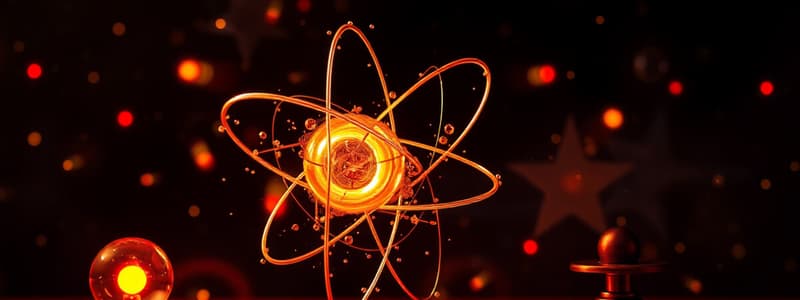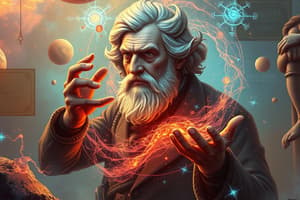Podcast
Questions and Answers
Who initially proposed the idea that matter is composed of tiny particles?
Who initially proposed the idea that matter is composed of tiny particles?
- Democritus (correct)
- John Dalton
- Ernest Rutherford
- Antoine Lavoisier
What does the law of conservation of mass state?
What does the law of conservation of mass state?
- Matter can only be created by chemical reactions.
- Matter can be created and destroyed.
- Matter cannot be created or destroyed, only changed in form. (correct)
- Matter is permanent and unchanging.
Which model proposed by J.J. Thompson describes the atom as having negative electrons dispersed within a positive medium?
Which model proposed by J.J. Thompson describes the atom as having negative electrons dispersed within a positive medium?
- The plum pudding model (correct)
- The planetary model
- The solid sphere model
- The nuclear model
What experiment did Ernest Rutherford conduct to prove the existence of the nucleus?
What experiment did Ernest Rutherford conduct to prove the existence of the nucleus?
What discovery did Rutherford make concerning the composition of the atom?
What discovery did Rutherford make concerning the composition of the atom?
What particles did J.J. Thompson identify while using cathode ray tubes?
What particles did J.J. Thompson identify while using cathode ray tubes?
What did Goldstein theorize about the atom's structure?
What did Goldstein theorize about the atom's structure?
What happens to some positive alpha particles in Rutherford's experiment?
What happens to some positive alpha particles in Rutherford's experiment?
According to Dalton's theory of elements, how are elements characterized?
According to Dalton's theory of elements, how are elements characterized?
What year did Antoine Lavoisier develop the law of conservation of mass?
What year did Antoine Lavoisier develop the law of conservation of mass?
What term did Leucippus and Democritus use to describe the tiny particles that make up matter?
What term did Leucippus and Democritus use to describe the tiny particles that make up matter?
What aspect of atomic theory did Antoine Lavoisier's discovery emphasize?
What aspect of atomic theory did Antoine Lavoisier's discovery emphasize?
According to J.J. Thompson's plum pudding model, what is the atom composed of?
According to J.J. Thompson's plum pudding model, what is the atom composed of?
What conclusion did Rutherford reach regarding the majority of an atom's composition?
What conclusion did Rutherford reach regarding the majority of an atom's composition?
What did Rutherford's gold foil experiment demonstrate about positive alpha particles?
What did Rutherford's gold foil experiment demonstrate about positive alpha particles?
What type of particles did J.J. Thompson identify as contributing to an atom's reactivity?
What type of particles did J.J. Thompson identify as contributing to an atom's reactivity?
What did Goldstein theorize about the atomic structure?
What did Goldstein theorize about the atomic structure?
What method did Rutherford use to investigate the atomic structure?
What method did Rutherford use to investigate the atomic structure?
How did Dalton describe elements in his atomic theory?
How did Dalton describe elements in his atomic theory?
What inference can be drawn about the mass of the particles identified by Thompson?
What inference can be drawn about the mass of the particles identified by Thompson?
What discovery did Antoine Lavoisier make regarding the composition of matter?
What discovery did Antoine Lavoisier make regarding the composition of matter?
What did J.J. Thompson use to identify the existence of electrons?
What did J.J. Thompson use to identify the existence of electrons?
What does the plum pudding model represent about the atom?
What does the plum pudding model represent about the atom?
What conclusion did Rutherford reach from his gold foil experiment?
What conclusion did Rutherford reach from his gold foil experiment?
What does the term 'nucleus' refer to in atomic theory?
What does the term 'nucleus' refer to in atomic theory?
How did Goldstein contribute to the understanding of atomic structure?
How did Goldstein contribute to the understanding of atomic structure?
What behavior was demonstrated by positive alpha particles in Rutherford's experiment?
What behavior was demonstrated by positive alpha particles in Rutherford's experiment?
What aspect of Dalton's atomic theory describes elements?
What aspect of Dalton's atomic theory describes elements?
In the context of atomic theory, what was a significant limitation noted by Rutherford?
In the context of atomic theory, what was a significant limitation noted by Rutherford?
What distinctive feature did Dalton attribute to each element?
What distinctive feature did Dalton attribute to each element?
What does the law of conservation of mass imply about matter?
What does the law of conservation of mass imply about matter?
What aspect of atomic structure did Goldstein identify?
What aspect of atomic structure did Goldstein identify?
What significant feature of Rutherford's findings about the atom was presented?
What significant feature of Rutherford's findings about the atom was presented?
What was J.J. Thompson's contribution to atomic theory?
What was J.J. Thompson's contribution to atomic theory?
Which feature distinguishes Dalton's atomic theory from previous ideas?
Which feature distinguishes Dalton's atomic theory from previous ideas?
What model represents J.J. Thompson's visualization of the atom?
What model represents J.J. Thompson's visualization of the atom?
In Rutherford's gold foil experiment, what caused alpha particles to deflect?
In Rutherford's gold foil experiment, what caused alpha particles to deflect?
How did Leucippus and Democritus characterize the tiny particles that constitute matter?
How did Leucippus and Democritus characterize the tiny particles that constitute matter?
What was the outcome regarding the structure of the atom proposed by J.J. Thompson?
What was the outcome regarding the structure of the atom proposed by J.J. Thompson?
What limitation was noted in Rutherford's findings after his experiment?
What limitation was noted in Rutherford's findings after his experiment?
Flashcards are hidden until you start studying
Study Notes
Development of Modern Atomic Theory
- Ancient Greek Philosophers: Leucippus and Democritus proposed that matter is composed of indivisible particles called "atomos".
- Lavoisier's Law of Conservation of Mass: Matter cannot be created or destroyed, only transformed.
- Dalton's Atomic Theory: Each element is made up of unique and distinct atoms with characteristic properties.
- Goldstein's Discovery: Atoms contain both positive and negative components contributing to their behavior.
- Thomson's Plum Pudding Model: Introduced the concept of electrons as negatively charged particles within a positively charged sphere.
- Rutherford's Gold Foil Experiment: Proved the existence of the nucleus, a dense, positively charged core within the atom.
- Rutherford's Conclusion: The atom is mostly empty space with a small, dense positively charged nucleus, and the negatively charged electrons are dispersed throughout the atom's space.
Ancient Greek Concepts About Atoms
- Leucippus and Democritus theorized that matter is composed of tiny particles, which they called "atomos" (meaning "indivisible").
- Their idea was groundbreaking, suggesting that matter had a fundamental building block.
Lavoisier's Contribution
- Antoine Lavoisier formulated the law of conservation of mass, stating that matter cannot be created or destroyed, only transformed.
- This law laid the foundation for understanding chemical reactions and the nature of matter.
Dalton's Atomic Theory
- John Dalton proposed that elements are distinct packets of matter, each with unique properties and behaviours.
- He emphasized that no two elements are exactly alike, leading to the concept of unique atomic identities.
The Investigation of Atomic Structure
- Goldstein suggested that atoms have both a positive and negative portion, hinting at the existence of subatomic particles.
- This idea formed the foundation for future discoveries about the structure of atoms.
Thomson's Plum Pudding Model
- Joseph John Thomson used cathode ray tubes to determine the tiny mass of cathode rays, which he identified as electrons – negatively charged particles.
- He proposed the "Plum Pudding Model," where electrons are distributed randomly within a positively charged sphere, resembling the structure of plum pudding.
Rutherford's Nuclear Model
- Ernest Rutherford conducted the famous "gold foil experiment," shooting positively charged alpha particles at a thin gold foil.
- He discovered that most of the alpha particles passed straight through the foil, indicating that atoms are mostly empty space.
- Some particles were deflected backwards, revealing the existence of a small, densely packed, positively charged region called the nucleus.
- Rutherford concluded that the nucleus is at the atom's center, and electrons occupy the vast space surrounding it.
- His model, however, didn't explain the exact location of electrons within the atom.
Key Figures in Atomic Theory
-
Democritus proposed the idea that matter is made up of tiny, indivisible particles called "atomos"
-
Antoine Lavoisier formulated the Law of Conservation of Mass, stating that matter cannot be created or destroyed, only transformed.
-
John Dalton developed the first atomic theory, asserting that:
- Elements are distinct packets of matter with unique properties.
- All atoms of a given element are identical.
- Atoms cannot be created, destroyed, or broken down into smaller particles.
Early Models of the Atom
-
Goldstein hypothesized the existence of both positive and negative components within the atom.
-
J.J. Thomson discovered electrons through experiments with cathode ray tubes.
- He proposed the plum pudding model, imagining the atom as a sphere of positive charge with negatively charged electrons dispersed throughout.
The Nucleus: Rutherford's Discovery
- Ernest Rutherford conducted the gold foil experiment, firing positively charged alpha particles at a thin gold foil.
- The results showed that most alpha particles passed straight through the foil, indicating the atom is mostly empty space.
- A small number of alpha particles were deflected back, revealing the presence of a densely packed, positively charged center called the nucleus.
- Rutherford's model could not explain the location of electrons.
Early Atomic Theory
- Democritus proposed that matter is made up of indivisible particles called atomos.
Key Laws and Theories
- Law of Conservation of Mass, proposed by Antoine Lavoisier, states that matter cannot be created or destroyed, only transformed.
- John Dalton expanded on Democritus’s ideas, stating that elements are distinct packets of matter with unique properties.
Atomic Structure
- Goldstein suggested that atoms have positive and negative portions.
- J.J. Thompson discovered electrons, negatively charged particles, using cathode ray tubes and proposed the plum pudding model which pictured electrons embedded in a positively charged sphere.
- Ernest Rutherford used the gold foil experiment to discover the nucleus of an atom.
- He bombarded a thin sheet of gold foil with positively charged alpha particles.
- Most of the particles passed straight through, indicating an atom is mostly empty space.
- A small percentage of particles deflected backwards, revealing a concentrated positively charged center, the nucleus.
- Rutherford’s experiment didn’t determine the location of electrons within the atom.
Studying That Suits You
Use AI to generate personalized quizzes and flashcards to suit your learning preferences.




